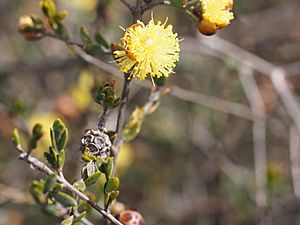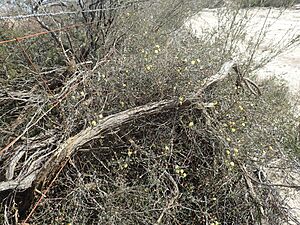Conothamnus facts for kids
Quick facts for kids Conothamnus |
|
|---|---|
 |
|
| Conothamnus aureus leaves, flowers and fruit | |
| Scientific classification |
|
| Kingdom: | Plantae |
| Clade: | Tracheophytes |
| Clade: | Angiosperms |
| Clade: | Eudicots |
| Clade: | Rosids |
| Order: | Myrtales |
| Family: | Myrtaceae |
| Subfamily: | Myrtoideae |
| Tribe: | Melaleuceae |
| Genus: | Conothamnus Lindl. |
| Synonyms | |
|
Trichobasis Turcz. |
|
Conothamnus is a group of flowering plants. These plants are found only in the south-west part of Western Australia. They are woody shrubs, which means they are like small, bushy trees.
Conothamnus plants are similar to another plant group called melaleucas. However, Conothamnus plants have leaves that usually grow in opposite pairs. Also, their fruit has only up to three seeds. Melaleucas, on the other hand, usually have leaves that grow one after another. Their woody fruit can hold hundreds of tiny seeds.
Contents
What Does a Conothamnus Plant Look Like?
Conothamnus plants are shrubs. Their thinner branches are covered with soft, silky hairs. The leaves are small and grow in pairs. They also have tiny oil glands, which are like small dots, on them.
Conothamnus Flowers
The flowers of Conothamnus plants can have both male and female parts. Some flowers might only have male parts. These flowers grow in small groups or spikes. You can find them where the leaves meet the branches, usually near the ends.
The flowers are white to yellow in color. They usually have 5 sepals (leaf-like parts protecting the bud) and 5 petals. However, one type, Conothamnus aureus, seems to not have petals.
There are many stamens in each flower. Stamens are the parts that produce pollen. They are arranged in 5 bundles around the edge of the flower. These stamens are also white to yellow. They are what give the flower its bright color. After the flower blooms, it turns into a woody capsule, which is a type of fruit.

How Conothamnus Plants Got Their Name
The name Conothamnus was first officially used in 1839. It was given by a scientist named John Lindley. He wrote about it in his book A Sketch of the Vegetation of the Swan River Colony.
Lindley noticed that Conothamnus was similar to Melaleuca. But it was different because its fruit had only three seeds, not many. He decided to call this interesting plant Conothamnus trinervis.
The name Conothamnus comes from two old Greek words. Kônos means "cone," and thamnos means "shrub."
Where Conothamnus Plants Grow
Conothamnus plants are only found in areas close to the coast in the south-west of Western Australia. They grow in different types of sandy soil. You can find them in gravelly areas, swampy plains, flat lands, and sand dunes.
Scientists recognize three main types of Conothamnus plants:
- Conothamnus aureus
- Conothamnus neglectus
- Conothamnus trinervis
See also
 In Spanish: Conothamnus para niños
In Spanish: Conothamnus para niños

